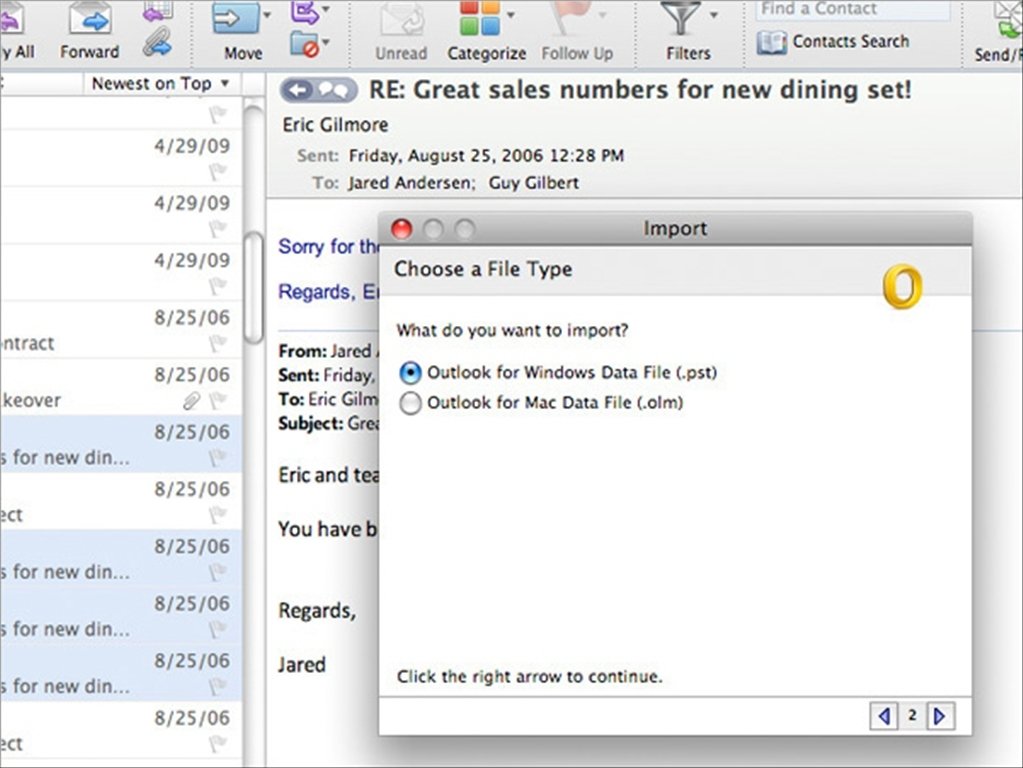Download Microsoft Exchange For Mac Rating: 3,8/5 7543 votes
Sep 02, 2015 Download Microsoft Outlook for Mac for Office 365. From Official Microsoft Download Center. This is your 365. Discover what's possible every day with Office 365. FOR UP TO 6 PEOPLE FOR 1 PERSON. Transform data into actionable insights with dashboards and reports. I'm not receiving email or other items in my Exchange account in Outlook for Mac. Outlook is not connected to the server that is running Microsoft Exchange Server. Empty the cache in Outlook so that Outlook can download all the items from your Microsoft Exchange account again. Jan 28, 2015 Outlook for iOS works with Microsoft Exchange, Office 365, Outlook.com (including Hotmail and MSN), Gmail, Yahoo Mail, and iCloud.-To make an in-app purchase of an Office 365 Home or Personal subscription, open the app, go to Settings, and tap on Upgrade next to your Outlook.com or Hotmail.com account. Will future releases of Microsoft Outlook support the use of Exchange ActiveSync on MAC OS? It's frustrating that I'm able to get full synchronization of mail, folders, contacts and calendars on iPhone and not on a Mac computer. After reviewing the threads posted by other users, this seems to be an issue that's been occurring for some time. May 20, 2019 Configure the Exchange server to support Compatible mode by using the instructions from KB article 980436. This allows the Outlook for Mac client to establish a connection by using the SSL protocol and then renegotiate by using TLS. This method allows Outlook for Mac to connect to the server even when SSL 2.0 and 3.0 are blocked.
-->PowerShell supports macOS 10.12 and higher.All packages are available on our GitHub releases page.After the package is installed, run pwsh from a terminal.
Note
PowerShell 7 is an in-place upgrade that removes PowerShell Core 6.x.
The /usr/local/microsoft/powershell/6 folder is replaced by /usr/local/microsoft/powershell/7.
If you need to run PowerShell 6 side-by-side with PowerShell 7, reinstall PowerShell 6 using thebinary archive method.
About Brew
Homebrew is the preferred package manager for macOS. If the brew command is not found, youneed to install Homebrew following their instructions. Otherwise you may install PowerShellvia Direct Download or fromBinary Archives.
Installation of latest stable release via Homebrew on macOS 10.12 or higher
See About Brew for information about Brew.
Now, you can install PowerShell:
Finally, verify that your install is working properly:
When new versions of PowerShell are released,update Homebrew's formulae and upgrade PowerShell:
Note
The commands above can be called from within a PowerShell (pwsh) host,but then the PowerShell shell must be exited and restarted to complete the upgradeand refresh the values shown in $PSVersionTable.

Installation of latest preview release via Homebrew on macOS 10.12 or higher
See About Brew for information about Brew.
After you've installed Homebrew, you can install PowerShell.First, install the Cask-Versions package that lets you install alternative versions of cask packages:
Now, you can install PowerShell:
Finally, verify that your install is working properly:
When new versions of PowerShell are released,update Homebrew's formulae and upgrade PowerShell:
Note
The commands above can be called from within a PowerShell (pwsh) host,but then the PowerShell shell must be exited and restarted to complete the upgrade.and refresh the values shown in $PSVersionTable.
Installation via Direct Download
Download the PKG packagepowershell-lts-7.0.0-osx-x64.pkgfrom the releases page onto your macOS machine.
You can double-click the file and follow the prompts,or install it from the terminal:
Install OpenSSL. OpenSSL is needed for PowerShell remoting and CIM operations.
Install as a .NET Global tool
If you already have the .NET Core SDK installed, it's easy to install PowerShellas a .NET Global tool.
The dotnet tool installer adds ~/.dotnet/tools to your PATH environment variable. However, thecurrently running shell does not have the updated PATH. You should be able to start PowerShellfrom a new shell by typing pwsh.
Binary Archives
PowerShell binary tar.gz archives are provided for the macOS platform to enable advanceddeployment scenarios.
Installing binary archives on macOS
Install OpenSSL. OpenSSL is needed for PowerShell remoting and CIM operations.
Installing dependencies
Install XCode command-line tools
Install OpenSSL
OpenSSL is needed for PowerShell remoting and CIM operations. You can install via MacPorts or Brew.
Install OpenSSL via Brew
Microsoft Outlook For Mac
See About Brew for information about Brew.
To install OpenSSL, run brew install openssl.
Download Microsoft Exchange For Mac Windows 10
Install OpenSSL via MacPorts
- Install the XCode command line tools.
- Install MacPorts.If you need instructions, refer to theinstallation guide.
- Update MacPorts by running
sudo port selfupdate. - Upgrade MacPorts packages by running
sudo port upgrade outdated. - Install OpenSSL by running
sudo port install openssl. - Link the libraries to make them available to PowerShell:
Uninstalling PowerShell
If you installed PowerShell with Homebrew, use the following command to uninstall:
If you installed PowerShell via direct download, PowerShell must be removed manually:
Microsoft font folder mac. To remove the additional PowerShell paths, refer to the paths section in this documentand remove the paths using sudo rm.
Note
This is not necessary if you installed with Homebrew.
Paths
$PSHOMEis/usr/local/microsoft/powershell/7.0.0/- User profiles will be read from
~/.config/powershell/profile.ps1 - Default profiles will be read from
$PSHOME/profile.ps1 - User modules will be read from
~/.local/share/powershell/Modules - Shared modules will be read from
/usr/local/share/powershell/Modules - Default modules will be read from
$PSHOME/Modules - PSReadline history will be recorded to
~/.local/share/powershell/PSReadLine/ConsoleHost_history.txt
The profiles respect PowerShell's per-host configuration.So the default host-specific profile exists at Microsoft.PowerShell_profile.ps1 in the same locations.
PowerShell respects the XDG Base Directory Specification on macOS.
Because macOS is a derivation of BSD, the prefix /usr/local is used instead of /opt.So, $PSHOME is /usr/local/microsoft/powershell/7.0.0/, and the symbolic link is placed at /usr/local/bin/pwsh.